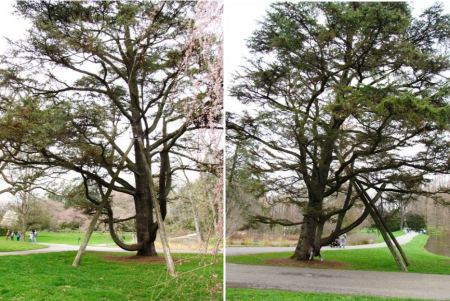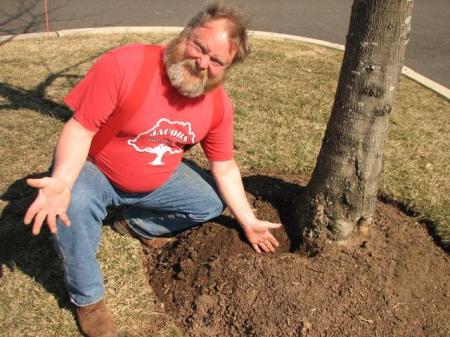I needed to show a client some examples of how an old and fragile tree can be supported by props. So I used that as an excuse to take Jodie and go on a little excursion to Longwood Gardens. (Note to the IRS: that’s why the company paid for our trip.)
Longwood has 2 nice examples of this kind of support system. One is this big cedar that has a threatening lean.
The other is this old decrepit mulberry. It looks like it should be cut down, doesn’t it? But Longwood keeps it alive because it is the record holder for largest mulberry in Pennsylvania. Sometimes there is a reason to make “heroic” efforts to preserve a “veteran” tree.
The props are made out of decay-resistant black locust logs that were cut somewhere on Longwood grounds. Pretty cool, huh? With that mission (getting those photos) accomplished, we spent the rest of the day enjoying Longwood’s many indoor and outdoor exhibits. I’ll share a few things I found interesting. Some of the lawns are meticulously maintained, like a golf course. But not all. I especially like the areas that are filled with spring-blooming flowers, like here.
Inside one othe the greenhouses, Jodie pointed out a plant that caught her eye (I forget what it was). I looked at it and said I didn’t think it was pretty. It had pale colored leaves. My sense of beauty appreciates dark green colored plants – I guess because I’m looking through arborist eyes. Green = chlorophyll = energy = healthy. Right after we stepped out of that building, I said “Look! That’s what I like. Look how dark green that tree is!”
Lastly, I shot a few pictures to show how Longwood mulches around their trees. This is the right way to do it!
Note: No trenches around the perimeter, you can always see the trunk flares, they cover a lot of square feet, and the material is: partly composted wood chips!












![mulch%20volcanoes[1] mulch volcano](https://jacobstreesurgery.files.wordpress.com/2012/06/mulch20volcanoes1.jpg?w=450)
![mulch%20volcano%202[1] mulch volcano](https://jacobstreesurgery.files.wordpress.com/2012/06/mulch20volcano2021.jpg?w=450)
![mulch%20volcano%203[1] mulch volcano](https://jacobstreesurgery.files.wordpress.com/2012/06/mulch20volcano2031.jpg?w=450)
![mulch%20volcano%204[1] mulch volcano](https://jacobstreesurgery.files.wordpress.com/2012/06/mulch20volcano2041.jpg?w=450)
![mulch%20volcano%205[1] mulch volcano](https://jacobstreesurgery.files.wordpress.com/2012/06/mulch20volcano2051.jpg?w=450)
![mulch%20volcano%206[1] mulch volcano](https://jacobstreesurgery.files.wordpress.com/2012/06/mulch20volcano2061.jpg?w=450)
![mulch%20volcano%207[1] mulch volcano](https://jacobstreesurgery.files.wordpress.com/2012/06/mulch20volcano2071.jpg?w=450)
![mulch%20volcano%208[1] mulch volcano](https://jacobstreesurgery.files.wordpress.com/2012/06/mulch20volcano2081.jpg?w=450)
![mulch%20volcano%209[1] mulch volcano](https://jacobstreesurgery.files.wordpress.com/2012/06/mulch20volcano2091.jpg?w=450)
![mulch%20madness%201[1]](https://jacobstreesurgery.files.wordpress.com/2012/06/mulch20madness2011.jpg?w=450)
![mulch%20madness%202[1]](https://jacobstreesurgery.files.wordpress.com/2012/06/mulch20madness20211.jpg?w=450)